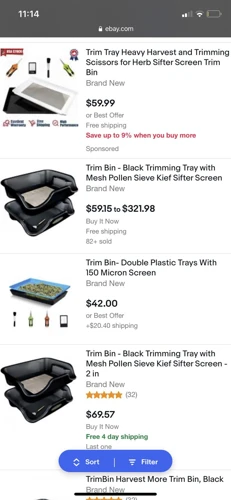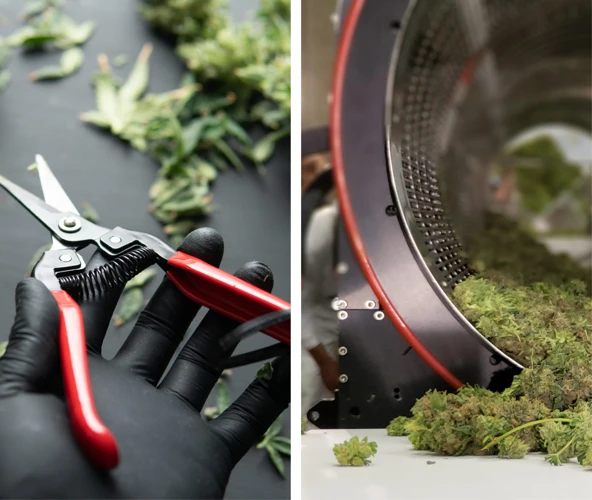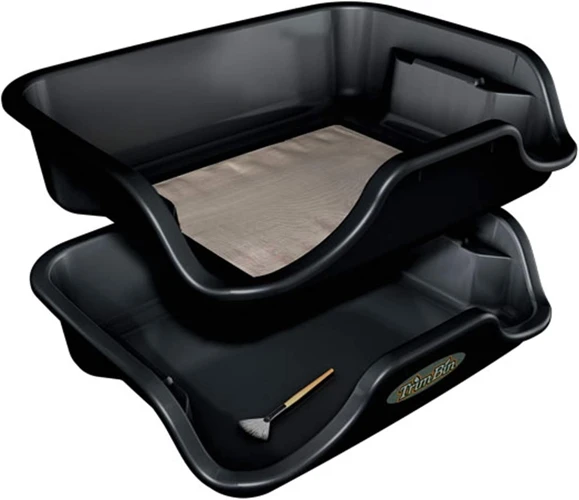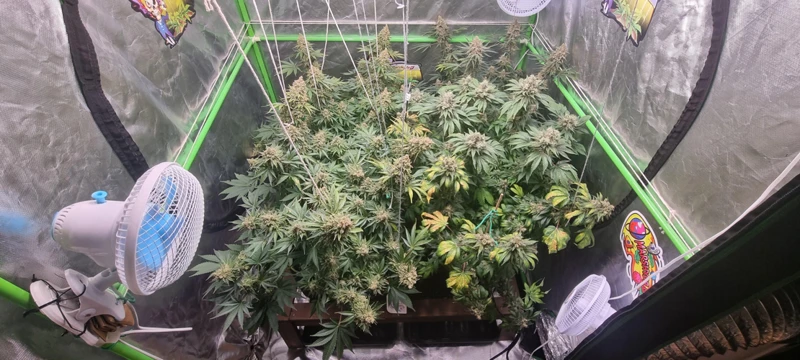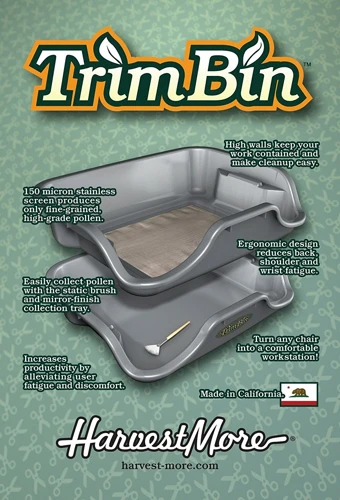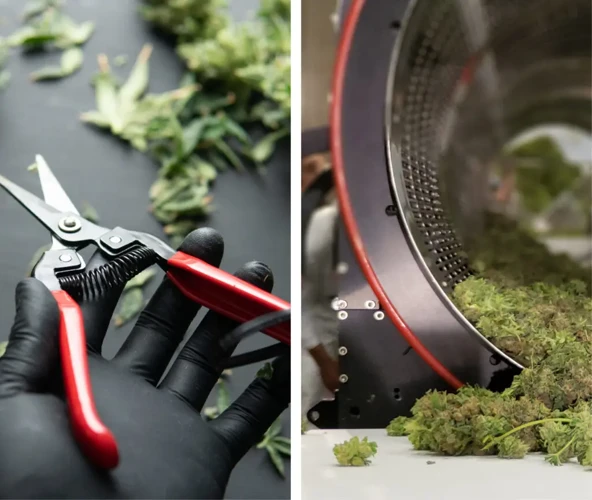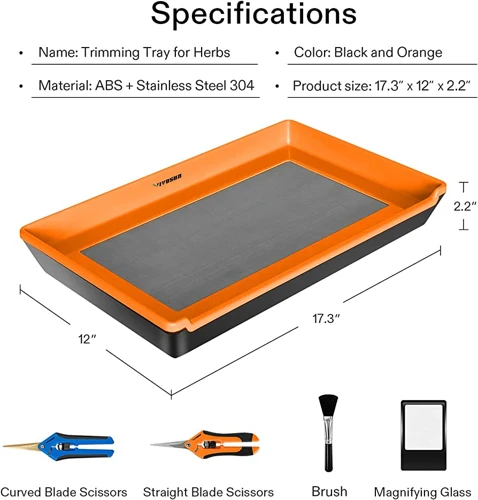
Is the Trim Bin Worth Your Investment? A Comprehensive Guide
As the demand for cannabis continues to grow, so does the need for efficient and precise trimming methods. With the countless options available, it may be challenging to determine which tool is worth the investment. But what if we told you there’s a solution that could make trimming quicker and easier? Enter the Trim Bin – a product that claims to streamline the trimming process and reduce time and energy spent on trim work. In this article, we’ll take a closer look at the Trim Bin to determine whether it’s worth the investment for trimming and explore its advantages, types available, factors to consider when purchasing, and how to use it correctly.
What is a Trim Bin?
Contents
When it comes to harvesting and trimming cannabis plants, there are various tools and equipment available for growers to choose from. One such tool that has gained popularity in recent years is the Trim Bin. But what exactly is a Trim Bin? Simply put, a Trim Bin is a type of trimming tray that helps simplify and streamline the process of trimming cannabis flowers. With an ergonomic design and efficient trimming capabilities, the Trim Bin is a valuable investment for any serious cannabis grower. Let’s take a closer look at how it works.
How Does it Work?
A Trim Bin is a trimming tool that makes the process of trimming buds faster and more efficient. It works by using a series of screens and filters to separate excess leaves and stems from the buds.
Here’s how it works:
- First, you place your buds in the Trim Bin.
- Next, you start shaking or gently stirring the buds around inside the bin.
- As you shake or stir, the screens and filters inside the bin separate the excess plant material from the buds.
- Eventually, the excess plant matter falls through the screens and is collected in a separate tray or container below the Trim Bin.
- Meanwhile, the buds remain in the upper portion of the bin, ready to be trimmed further or used as desired.
The Trim Bin makes trimming faster and easier by automating the process of removing excess plant material from buds. Whether you’re a professional grower or a home cultivator, using a Trim Bin can help you save time and streamline your operations.
Advantages of Using a Trim Bin
When it comes to trimming cannabis, many growers are constantly seeking ways to streamline their process and increase efficiency. One product that has gained widespread popularity in recent years is the trim bin. This simple yet effective tool offers numerous advantages over traditional trimming methods, making it a wise investment for any serious grower. From its ergonomic design to its ability to minimize mess and increase precision, the trim bin is a game changer in the world of cannabis cultivation. Let’s take a closer look at the many benefits of using a trim bin for trimming.
Ergonomic Design
One of the advantages of using a Trim Bin for trimming is its ergonomic design. Working long hours trimming buds by hand can cause strain on your back, neck, and shoulders. However, the Trim Bin is designed to alleviate some of that strain by offering a comfortable and supportive work surface.
Here are some of the ergonomic features of the Trim Bin:
- Raised Edges: The Trim Bin has raised edges that prevent buds from falling off the work surface. This allows you to work at a more natural angle and position without having to constantly bend over to pick up fallen buds.
- Comfortable Arm Rests: The Trim Bin also features comfortable arm rests that provide support for your arms, reducing strain on your neck and shoulders. The arm rests are also angled to allow for better hand positioning and reduced wrist fatigue.
- Non-Slip Base: The Trim Bin has a non-slip base that keeps it firmly in place while you work. This prevents any unnecessary movement or sliding, which can contribute to discomfort or strain.
- Lightweight and Portable: The Trim Bin is lightweight and portable, which makes it easy to move around your workspace as needed. Whether you need to change positions or move to a different area, the Trim Bin can easily come along with you.
The ergonomic design of the Trim Bin is intended to make trimming a more comfortable and less stressful experience. By reducing strain on your body, you can work more efficiently and effectively, ultimately leading to better-quality product and a happier, healthier you.
Easy to Use
Using a Trim Bin is not only efficient and ergonomic but also very easy to use. The set-up process is simple and requires no special skills or tools. Most Trim Bins come with instructions, however, their simple design makes them self-explanatory.
With its lightweight and portable design, a Trim Bin can be moved from one location to another with ease, making it a great tool for both personal and commercial use. The high walls surrounding the Trim Bin prevent any buds, leaves or stems from flying out, keeping your workspace clean and mess-free.
One of the reasons why a Trim Bin is so easy to use is that you simply need to place the buds into the tray, and then gently shake or rotate the bin. Because of the basket’s shape and pattern, it achieves a precision cut every time, without you needing to manually cut every single bud.
Here’s a table summarizing the advantages of the easy-to-use Trim Bin:
| Advantages of Easy-to-Use Trim Bin |
|---|
| Simple set-up process, requiring no special skills or tools |
| Lightweight and portable design, making it easy to move around |
| High walls to contain any mess, keeping your workspace clean |
| No need for manual cutting |
| Precision cut every time |
The Trim Bin’s ease-of-use makes it attractive for those who want to trim buds in less amount of time with less effort. The Trim Bin design allows for a more efficient and effortless trimming experience while ensuring you get the best possible cut.
Efficient Trimming
One of the biggest advantages of using a Trim Bin for trimming is its efficient performance. With a Trim Bin, you can get the job done quickly and easily, without compromising on the quality of your trim.
Using a Trim Bin allows you to trim your buds quickly and efficiently, without the need for additional tools or equipment. With its built-in screens and trays, a Trim Bin ensures that your buds are separated from their stems and leaves, making it easier to identify and trim the areas that need attention. This can save you a significant amount of time and effort, particularly if you are dealing with a lot of buds at once.
The ergonomic design of a Trim Bin ensures that you can work comfortably and efficiently for extended periods of time. The angled sides of the bin provide a natural resting position for your wrists and forearms, reducing strain and fatigue. The bin’s sturdy construction also ensures that it can withstand repeated use without degrading over time.
Using a Trim Bin promotes precision and accuracy in your trimming process. With the built-in screens and trays, you can separate your buds into different sections based on size or quality, allowing you to trim them accordingly. This enables you to produce a more consistent and uniform final product, with little to no wasted material.
The efficient trimming capabilities of a Trim Bin make it a valuable investment for any serious grower or cultivator. With its built-in features and ergonomic design, you can save time and effort while producing a high-quality trim every time.
| Advantages of Efficient Trimming with a Trim Bin |
|---|
| Time-saving: Allows you to trim buds quickly and efficiently without compromising quality. |
| Ergonomic design: Promotes comfortable and efficient trimming for extended periods of time, reducing strain and fatigue. |
| Precision and accuracy: Separates buds into different sections based on size or quality, allowing for a more consistent and uniform final product with little to no wasted material. |
Less Mess, More Precision
One of the advantages of using a trim bin is that it reduces the mess typically associated with trimming cannabis buds. The ergonomic design of trim bins helps to minimize the amount of plant matter and debris that falls on the floor or work surface. Additionally, using a trim bin allows for greater precision in trimming, which means less wasted material and higher quality buds.
Here are some specific ways in which trim bins help to reduce mess and improve precision when trimming:
- Trim bins have a built-in screen or mesh that separates the trimmed buds from the excess plant matter.
- This plant matter is collected in a separate section of the trim bin, which can be easily emptied and discarded when full.
- Using a trim bin also helps to contain the spread of aromas and trichomes during the trimming process, which can be especially important for those working in close quarters or sensitive environments.
- The mesh or screen of the trim bin also serves as a guide for cutting, helping to ensure a consistent and even trim every time.
- With less plant matter and debris to clean up, trimming with a trim bin saves time and reduces the overall workload of the trimming process.
The ability of trim bins to reduce mess and improve precision leads to a more efficient and enjoyable trimming experience, with higher quality results.
Types of Trim Bins Available
Are you ready to invest in a trim bin for your trimming needs, but aren’t sure what type to choose? With so many options available, it can be overwhelming to make a decision. But don’t worry, we’ve got you covered! Read on to learn about the plastic, stainless steel, and electric trim bins available, and which might be the best fit for your operation.
Plastic Trim Bins
Plastic trim bins are the most common type of trim bin and are popular among beginner trimmers due to their affordability. These bins are made of durable plastic material that can withstand heavy use and can last for multiple harvests. Here are some of the advantages and disadvantages of using plastic trim bins:
Advantages:
- Lightweight and easy to move around.
- Cost-effective compared to other materials.
- Easy to clean and maintain.
- Available in various sizes to fit different trimming needs.
Disadvantages:
- Not as durable as stainless steel trim bins.
- May produce static which can cause trimmings to cling to the bin.
- Not as aesthetically pleasing as other materials.
- May release harmful chemicals if exposed to high heat.
Plastic trim bins are a great option for those who are just starting out with trimming and want an affordable option. However, they may not be the best choice for those who want a more durable and long-lasting trim bin or for those who are concerned about possible health risks associated with the material.
Stainless Steel Trim Bins
When it comes to choosing a trim bin, one of the options available in the market is a stainless steel trim bin. This type of bin is known for its durability, sturdiness, and ease of cleaning. Conversely, it is also one of the most expensive options compared to plastic trim bins.
Here is a comparison table of plastic and stainless steel trim bins:
| Features | Plastic Trim Bins | Stainless Steel Trim Bins |
|---|---|---|
| Price | Less expensive | More expensive |
| Durability | Less durable | Extremely durable |
| Easy to Clean | Relatively easy to clean | Very easy to clean |
| Sturdiness | Less sturdy | Extremely sturdy |
| Weight | Lightweight | Heavier |
Stainless steel trim bins can handle a lot of wear and tear. They are very sturdy and can withstand more weight than their plastic counterparts. They are ideal for those who have a large-scale operation and need a bin that can handle the volume of the trimming work.
One of the biggest advantages of stainless steel trim bins is their easy cleaning process. You can simply wipe them down with a clean cloth or rinse them off with water. They are also much easier to sanitize, which is important when it comes to preventing contamination.
However, there are some drawbacks to stainless steel trim bins. They are heavier and bulkier compared to plastic trim bins, which could make it difficult to move them around or store them in tight spaces. Additionally, they also come with a higher price tag, which may not be feasible for some growers or trimmers.
All in all, if you are looking for a durable and easy-to-clean trim bin that can handle heavy volumes of trimming work, then a stainless steel trim bin could be a good investment.
Electric Trim Bins
Electric trim bins are a more advanced option compared to plastic or stainless steel ones. These are, as the name suggests, powered by electricity and have more features that can help improve your trimming efficiency. Here are some of the features of electric trim bins that you might find helpful:
- Multiple Blades: Electric trim bins are equipped with multiple blades that can help trim your buds faster and more efficiently. With these trim bins, you won’t have to manually trim each bud using scissors or pruners, which can save you a lot of time and effort.
- Adjustable Settings: You can adjust the speed and intensity of the blades to match the buds you’re trimming. This can help you achieve a more precise trim and prevent damaging your buds, which can happen with manual trimming.
- Larger Capacity: Electric trim bins can handle larger amounts of buds compared to manual ones. This is especially useful if you have a larger operation and need to trim a lot of buds in a shorter amount of time.
- Noise Level: Since electric trim bins are powered by electricity, they can be quite loud. However, some models have noise-reducing features that can help minimize the noise level, which is something to consider when choosing an electric trim bin.
- Cleaning: Electric trim bins can be more difficult to clean compared to manual options. You’ll need to disassemble the machine and clean each component carefully to ensure that no plant matter is left behind.
Electric trim bins are a great option for those who have larger operations or need to trim a lot of buds quickly. They are more expensive than manual options, but the increased efficiency and precision can be well worth the investment. Just make sure to choose a model with adjustable settings and noise-reducing features if those are important factors for you.
Factors to Consider When Choosing a Trim Bin
When it comes to choosing a trim bin, there are a few important factors to consider. With several types of trim bins available in the market, choosing the right one that suits your operation’s needs can be perplexing. It is essential to consider the size of your operation, your budget, and your tolerance for noise level. In this section, we will discuss these factors in detail, to help you make an informed decision when choosing a trim bin.
Size of Your Operation
When choosing a trim bin, it’s important to consider the size of your operation. Here are some factors to keep in mind:
- Size of your crop: If you have a large harvest, you’ll want a trim bin that can accommodate a lot of buds at once. Consider a larger size or multiple bins to speed up the process.
- Number of employees: If you have a team of trimmers, you’ll want to make sure the trim bin is large enough for everyone to work comfortably. Some bins have multiple trimming platforms so that multiple workers can trim at once.
- Frequency of trimming: If you only trim buds occasionally, you might not need a large trim bin. However, if you trim often, investing in a larger bin could save you time and increase efficiency.
- Space available: Consider the amount of space you have in your workspace for the trim bin. If you have limited space, you might need to opt for a smaller or more compact trim bin.
Ultimately, it’s important to choose a trim bin that fits the unique needs of your operation.
Budget
When it comes to choosing a trim bin, budget is a crucial factor to consider. You don’t want to overspend and break the bank, but at the same time, you don’t want to go for the cheapest option and compromise on quality. Here are some things to keep in mind when deciding how much to spend:
| Factor | Consideration |
|---|---|
| Frequency of Use | If you plan to trim frequently, it may be worth investing in a more expensive and durable trim bin. |
| Size of Operation | If you have a larger operation or plan to expand, you may want to invest in a more expensive and larger trim bin. |
| Material | Stainless steel trim bins are generally more expensive than plastic ones, but they often last longer and are easier to clean. |
| Features | Electric trim bins are the most expensive option, but they can also save time and increase efficiency. |
Ultimately, you need to decide what your budget is and what you can afford. Keep in mind that a higher price tag doesn’t always guarantee better quality, so it’s important to do your research and read reviews before making a decision. Additionally, some sellers may be willing to offer warranties or payment plans, which can make a more expensive trim bin more feasible for your budget.
Tolerance for Noise Level
It is important to consider the noise level when choosing a Trim Bin, especially if you plan to use it frequently or have a low tolerance for noise. Below is a table outlining the noise levels for each type of Trim Bin:
| Trim Bin Type | Noise Level |
| Plastic Trim Bins | Low to moderate |
| Stainless Steel Trim Bins | Low to moderate |
| Electric Trim Bins | High |
As you can see, plastic and stainless steel Trim Bins have a low to moderate noise level, which is typically tolerable for most users. However, electric Trim Bins can be quite loud due to the motor, which may not be suitable for those who prefer a quieter working environment.
It is important to consider your own tolerance for noise before selecting a Trim Bin. If you plan to use it in a shared space or during hours when noise is an issue, then choosing a low to moderate noise level option is likely your best choice. On the other hand, if noise is not a concern or you plan to use the Trim Bin in a private space, then an electric model may be the right fit for you.
How to Use a Trim Bin
If you’ve decided to invest in a trim bin for your cannabis trimming needs, you’ll be pleased to know that it’s a simple and efficient tool to use. However, it’s important to understand the proper techniques for using a trim bin to ensure the best results. In this section, we’ll walk you through the step-by-step process of using a trim bin, from setting up your work station to preparing your buds and beginning the trimming process. By the end, you’ll feel confident in your ability to use your trim bin effectively and efficiently.
Set Up Your Work Station
To set up your work station for using a Trim Bin, you will need a few items to ensure maximum efficiency and cleanliness. Here is a breakdown of what you will need and how to set it up:
Table: Items and how to set up the work station
| Item | How to Set Up |
|---|---|
| Trim Bin | Place the Trim Bin on a sturdy surface at a comfortable height for trimming. Ensure that it is stable and secure to prevent accidents. |
| Light Source | Position a bright light source above and over the work station to ensure good visibility of the buds. This improves accuracy and efficiency in trimming. |
| Clean Tray | Place the clean tray next to the Trim Bin to keep the trimmed buds and debris separated from the untrimmed ones. This also helps to contain messiness while trimming. |
| Scissors/Pruners | Keep a pair of scissors or pruners within reach for snipping larger stems and hard-to-reach parts of the buds. This allows you to be more precise in your trimming. |
| Cleanup Tools | Have a set of cleaning tools nearby to help tidy up the work station once the trimming is complete. This may include a brush, a scraper, or a vacuum for easy cleanup. |
Setting up your work station before using a Trim Bin ensures that you have everything you need to make the trimming process efficient and smooth. Keep in mind that a well-organized work station not only saves time but also reduces the risk of accidents and keeps the buds clean and tidy.
Prepare Your Buds
Before starting to use your trim bin, it’s important to prepare your buds properly to achieve the best results. Here are some steps to follow for preparing your buds:
| Step 1: | Pre-Trimming |
| Description | Pre-trim your buds by removing any large fan leaves that could get in the way of trimming. This will help to make the trimming process smoother and more efficient. |
| Step 2: | Drying |
| Description | Ensure that your buds are properly dried before trimming. Moist buds will stick to the bin and make the process more difficult. Let your buds dry for at least 48 hours before using the trim bin. |
| Step 3: | Prepare Your Work Station |
| Description | Organize your work station and place your trim bin on a flat surface. Make sure that your bin is clean and free from any debris that could affect the quality of your trimming. Have your scissors and pruners ready for use. |
By properly preparing your buds, you can ensure that you get the best results from using your trim bin. It’s important to take the time to properly clean and set up your work space before beginning to trim, so that you can work efficiently and effectively.
Start Trimming
Once you have set up your work station and prepared your buds, it’s time to start trimming with your Trim Bin. Here are the steps to follow:
- Place the buds in the Trim Bin: Take a handful of buds and place them in the Trim Bin.
- Shake the Trim Bin: Holding onto the Trim Bin with both hands, shake it gently back and forth. The movement will cause the buds to rub against the screen and the trim will fall through into the catchment area.
- Inspect the Trim: Once you have shaken the Trim Bin for a few minutes, inspect the trim that has fallen into the catchment area. Use your fingers or a scraper to collect the trim and set it aside for use in extracts or other products.
- Repeat the Process: Take another handful of buds and repeat the shaking process until you have trimmed all of your buds.
Remember to take breaks as needed and to empty the catchment area periodically to prevent overloading the Trim Bin. With practice, you’ll be able to trim your buds quickly and efficiently with your Trim Bin.
Maintenance and Cleaning Tips
Proper maintenance and cleaning of your trim bin is essential to ensure its longevity and optimal performance. Here are some tips to help keep your trim bin in top condition.
Empty Your Trim Bin Regularly: Make sure to clear out your trim bin after every use. This will help prevent build-up and ensure that it remains hygienic.
Clean Your Trim Bin with Rubbing Alcohol: Use rubbing alcohol to clean your trim bin thoroughly. This will help remove any leftover plant matter and prevent bacteria growth. Be sure to wipe it down with a clean cloth afterward.
Avoid Using Harsh Chemicals: Avoid using any harsh chemicals or detergents to clean your trim bin. They may corrode or damage the material, affecting the quality of your trim.
Store Your Trim Bin Properly: Store your trim bin in a dry and cool place when not in use. Make sure it is covered or sealed tightly to keep out dust and debris.
Check for Wear and Tear: Regularly check your trim bin for any signs of wear and tear. This will help identify any issues that need addressing before they become larger problems.
Replace Any Damaged Parts: If you notice any damaged or broken parts of your trim bin, make sure to replace them as soon as possible. This will help prevent further damage and ensure that your trim bin remains effective.
By following these maintenance and cleaning tips, you can ensure that your trim bin remains in top condition for years to come, providing you with efficient and precise trimming every time.
Common Mistakes to Avoid When Using a Trim Bin
When using a Trim Bin, there are common mistakes that you should be aware of to make sure that you are getting the most out of your investment.
Overloading the trim bin: One of the most common mistakes people make when using a Trim Bin is overloading it with trimmings. This can cause the trimmings to spill over the edge, making a mess and decreasing the efficiency of the device. Make sure to trim in small batches to avoid overloading the Trim Bin.
Not cleaning the Trim Bin regularly: Cleaning your Trim Bin regularly is essential for keeping it in good condition and making sure that it lasts long. If you don’t clean the Trim Bin regularly, the trimmings can build up and cause clogging, which can affect the performance of the device. Always follow the manufacturer’s instructions on how to clean your Trim Bin.
Using the wrong type of Trim Bin for your needs: Choosing the right type of Trim Bin for your needs is essential to ensure you get the best results. For example, if you have a small operation, a plastic trim bin might be better suited to your needs than a stainless steel trim bin. Consider the size of your operation, budget and tolerance for noise level when choosing the right trim bin.
Not using protective gear: When using a Trim Bin, it is essential to wear protective gloves to avoid any accidental cuts from the sharp trimming tools. It’s also recommended to wear protective eyewear to avoid any potential eye injuries.
Not being mindful of the noise level: While electric trim bins can be efficient, they can also be loud, which can be a problem if you have other people living nearby. When using an electric trim bin, make sure to be mindful of the noise level and take steps to minimize the noise level, such as insulating the room or using earplugs.
By being mindful of these common mistakes, you can avoid damaging your Trim Bin, ensure it lasts long, and get the most efficient results from your investment.
FAQs About Trim Bins
As you explore the world of trim bins, you may have questions about their use, benefits, and limitations. To help alleviate any confusion, we’ve compiled a list of frequently asked questions (FAQs) about trim bins. From the amount of trim you can expect to the need for additional tools, we’ll address some of the most common concerns to help you make an informed decision about whether a trim bin is right for you.
How Much Trim Can I Expect from Using a Trim Bin?
When it comes to figuring out how much trim you can expect from using a trim bin, the amount can vary depending on a few factors. These factors include the size of your bud or flower, how much leaf material there is on the plant, and the type of trim bin you are using.
However, it’s important to note that using a trim bin can help you achieve a higher yield compared to hand-trimming. This is because the precision blades on the trim bin can remove more leaf material, leaving you with a cleaner bud that still maintains its trichomes.
According to some manufacturers, the trim yield can range from 10-25% on average. However, it’s important to keep in mind that the final amount of trim will also depend on your technique and the type of product you are trimming.
Here’s a breakdown of how much trim you can expect based on the type of product:
| Type of Product | Potential Trim Yield |
|---|---|
| Flower/Buds | 10-25% |
| Wet Trimmed Material | 25-30% |
| Dry Trimmed Material | 15-20% |
Note: These numbers are just estimates and should not be treated as a guarantee. Your trim yield may vary depending on different factors as mentioned above.
Can I Use a Trim Bin for Wet Trimming?
Wet trimming is the process of trimming the excess leaves from the cannabis buds immediately after the harvest while the buds are still wet. Wet trimming has its advantages and disadvantages – it can result in a cleaner, more visually appealing finished product, but it can also dry out the buds more quickly, which can affect their flavor and potency.
Using a trim bin for wet trimming is not recommended. Wet buds can stick to the surface of the bin, making it difficult to work with and potentially damaging the delicate buds. Additionally, the moisture from wet buds can cause buildup in the trim bin, making it harder to keep clean and maintain over time.
It’s best to use a dedicated wet trimming tray designed specifically for this process. Wet trimming trays are typically made of non-stick materials like silicone or stainless steel, which prevents the buds from sticking, and are easy to clean with soap and water.
Ultimately, the decision to wet trim or dry trim, and what tools and equipment to use, depends on personal preference and the specific needs of your operation. It’s important to weigh the pros and cons of each method before making a decision.
| Advantages of Wet Trimming | Disadvantages of Wet Trimming |
|---|---|
| – Results in a clean, visually appealing finished product | – Can dry out buds more quickly, affecting flavor and potency |
| – Can be easier to trim wet leaves compared to dry leaves | – Wet buds can stick to surfaces and potentially be damaged |
| – Trimming wet buds can be faster than trimming dry buds | – Buildup and moisture can cause equipment to malfunction or break down |
Will I Still Need Scissors and Pruners?
When it comes to the question of whether or not you still need scissors and pruners when using a trim bin, the answer is a resounding yes. While the trim bin is incredibly efficient at separating the plant material from the excess plant matter, it still requires manual labor on the part of the user. This means that you will still need scissors and pruners to get the job done quickly and efficiently.
What are Scissors and Pruners Used for?
Scissors and pruners are essential tools for any cannabis grower or trimmer. They are used to trim excess leaves and stems from the bud, creating a clean and attractive final product. They are also highly effective at removing any remaining bits of plant matter that are too small for the trim bin to catch.
How to Use Scissors and Pruners When Using a Trim Bin
To get the most out of your trim bin, it is important to use your scissors and pruners effectively. Start by using scissors to remove any large fan leaves and stems from the buds. Then, use the pruners to trim down the remaining leaves until only the clean, trimmed bud is left. This will ensure that your buds are ready to be placed in the trim bin for the final separation process.
Can You Use Only Scissors and Pruners?
While it is technically possible to trim your buds using only scissors and pruners, it is not the most efficient method of trimming. Using a trim bin will save you time and effort, and will ensure that you get the maximum amount of usable product from your plants. However, scissors and pruners are still an essential part of any trimming process and should not be neglected.
To summarize, it is important to keep in mind that while a trim bin is an incredibly useful tool for trimming cannabis, it does not replace the need for scissors and pruners. These tools are still necessary for preparing your buds for the final separation process, and will ensure that you get the most out of your harvest. So, when investing in a trim bin, remember to also invest in a good pair of scissors and pruners to accompany it.
| Proper Use of Scissors and Pruners | Benefits |
|---|---|
| Use scissors to trim large fan leaves and stems from the buds | Create a clean final product |
| Use pruners to trim down remaining leaves | Remove small bits of plant matter that the trim bin can’t catch |
| Trim buds using only scissors and pruners | Not the most efficient method of trimming |
Conclusion
After careful consideration of the features and benefits provided by Trim Bins, it can be concluded that they are worth the investment for trimming. With its ergonomic design, easy-to-use functionality, and efficient trimming capabilities, Trim Bins are a game-changer for trimming in the cannabis industry.
One of the biggest advantages of using Trim Bins is the precision and control it provides during the trimming process. The less mess and waste produced allows for a cleaner work space and more accurate trimming. Additionally, the different types of Trim Bins available, including plastic, stainless steel, and electric options, provide an array of choices for varying budgets and preferences.
The factors to consider when choosing a Trim Bin, such as the size of the operation and the tolerance for noise level, should be weighed carefully to ensure the best fit for your specific needs. It is important to note that while Trim Bins are efficient and effective in trimming, they should not be the only tool used in the process. Scissors and pruners may still be necessary for certain areas and finishing touches.
In terms of maintenance and cleaning of the Trim Bin, simple steps like regular wiping down and air-drying can extend its longevity. Additionally, avoiding common mistakes like overloading or using the wrong type of buds can help prevent damage or malfunctioning.
Overall, Trim Bins are a valuable addition to any cannabis trimming operation. With their flexibility in size and type, and the precision and control provided during the trimming process, Trim Bins are a sound investment that will improve the overall efficiency and quality of your work.
Frequently Asked Questions
What is the ideal size for a Trim Bin?
The ideal size of a trim bin will depend on the size of your operation and your personal preferences. However, most trim bins come in sizes that range from 15 to 24 inches long to accommodate up to a pound of trimmed buds.
Can I use a Trim Bin for dry trimming?
Yes, trim bins are perfect for dry trimming as they allow you to take your time and work with precision while minimizing the mess that comes with the process.
What is the difference between a plastic and stainless steel trim bin?
A plastic trim bin is lightweight and affordable, making it perfect for small to medium-sized operations. A stainless steel trim bin is more durable, easier to clean, and perfect for larger operations.
What is an electric trim bin?
An electric trim bin is a motorized trimmer with a built-in vacuum system that allows you to trim your buds quickly and with ease. This type of trim bin is ideal for large scale operations.
Do I still need scissors and pruners when using a trim bin?
Yes, you may still need scissors and pruners when using a trim bin, especially when trimming hard-to-reach areas or tough stems.
How do I clean my trim bin?
To clean your trim bin, simply wipe it down with a damp cloth or rinse it with water and mild soap. Make sure to dry it completely before using it again.
What are common mistakes to avoid when using a trim bin?
Some common mistakes to avoid when using a trim bin include overloading the bin, trimming too quickly or aggressively, and not cleaning the bin after each use.
How much noise does an electric trim bin make?
Electric trim bins can be quite loud, producing noise levels of up to 85 decibels. To minimize noise, consider using ear protection or choosing a quieter model.
What is the average lifespan of a trim bin?
The average lifespan of a trim bin will depend on the type, quality, and frequency of use. However, with proper maintenance and care, a trim bin can last for several years.
Can I use a trim bin for wet trimming?
Yes, some trim bins are designed for wet trimming, but be sure to check the product specifications before using it for this purpose.

